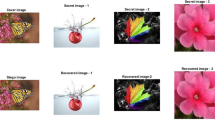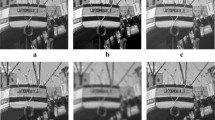Abstract
Rapid advances in digital technology have facilitated us to transfer a huge amount of electronic files over the internet. But in the presence of malicious attackers, the security, as well as the integrity of such important files, becomes of utmost importance. Steganography, an art of hiding the data, ensures the security of these files over the internet, and this method has been used for a long. In this paper, our purpose is two-fold. First, the Ballot transform (BaT) produces an integer polynomial sequence in coefficient form for each non-overlapping m-pixel groups (m = 2 or 3) of the cover image. Second, the Genetic Algorithm (GA) is applied to generate a k-digit password using a method called Index Value Mapping (IVM) which decides positions of the transformed coefficients where the bits of the secret data can be embedded. The key idea of using GA here is to produce an optimal output in terms of stego image quality instead of using an exhaustive search considering all combinations of k number of bits. Experimental results show that the proposed method not only offers acceptable Peak Signal-to-Noise Ratio (PSNR) values with considerable payload but also provides two-way security of the data being transmitted over the digital medium.










Similar content being viewed by others
References
Al-Dmour H, Al-Ani A (2016) A steganography embedding method based on edge identification and XOR coding. Expert Syst Appl 46:293–306
Almomani A, Al Bazar H, Sumari P, Gupta B, Atawneh S (2017) Secure and imperceptible digital image steganographic algorithm based on diamond encoding in DWT domain. Multimed Tools Appl 76:18451–18472
Atta R, Ghanbari M (2018) A high payload steganography mechanism based on wavelet packet transformation. J Vis Commun Image R 53:42–54
Ayatollahi A, Mirzakuchaki S, Hajizadeh H (2013) A new high capacity and EMD-based image steganography scheme in spatial domain. In: 2013 21st Iranian conference on electrical engineering (ICEE), Mashhad, Iran
Bajwa IS, Ali M, Riasat R (2011) A Hash-Based Approach for Colour Image Steganography. In: International Conference on Computer Networks and Information Technology, Pakistan
Barry P (2005) A catalan transform and related transformations on integer sequences. J Integer Seq 8:1–24
Boehm B (2014) StegExpose - a tool for detecting LSB steganography. Multimed Cryptography Secur:1–11
Weber AG (2019) USC-SIPI Image Database: Version 5, Original release: October 1997, Signal and Image Processing Institute, University of Southern California, Department of Electrical Engineering. http://sipi.usc.edu/database/. Accessed on 23 Sept 2019
Chatterjee B, Singh PK, Yoon JH, Geem ZW, Sarkar R, Bhattacharyya T (2020) Mayfly in harmony: a new hybrid meta-heuristic feature selection algorithm. IEEE Access 8:195929–195945
Chen W-Y (2008) Color image steganography scheme using DFT, SPIHT, codec, and modified differential phase-shift keying techniques. Appl Math Comput, Elsevier 196:40–54
Chen M, Fridrich J, Boroumand M (2018) Deep Residual Network for Steganalysis of Digital Images. IEEE Trans Inf Forensics Secur 14:1181–1193
Al-Jarrah M (2018) “RGB-BMP Steganalysis Dataset”, Mendeley Data, version 1, https://doi.org/10.17632/sp4g8h7v8k.1. Accessed on 14 Jan 2020
Wu D. C., & Tsai W. H. (2003) A steganographic method for images by pixel-value differencing. Pattern Recogn Lett 24:1613–1626
Du R, Fridrich J, Golijan M (2001) Detecting LSB steganography in color, and gray-scale images. Multimedia, IEEE 8:22–28
Falahi A, Hasanzadeh M (2012) A new image steganography method using genetic algorithm and corner detection. In: 9th International ISC Conference on Information Security and Cryptology
Gashkov SB (2015) Arithmetic complexity of certain linear transformations. Math Notes 97:531–555
Ghosal SK, Mandal JK (2014) Binomial transform based fragile watermarking for image authentication. J Inform Secur Appl Elsevier 19(4–5):272–281
Li H, He F, Chen Y (2020) Learning dynamic simultaneous clustering and classification via automatic differential evolution and firework algorithm. Appl Soft Comput 96:106593
He F, Zeng X, Liang Y (2020) 3D mesh simplification with feature preservation based on whale optimization algorithm and differential evolution. Integr Comput-Aided Eng 27:417–435
He F, Chen Y, Luo J, Li H (2020) Multi-objective self-organizing optimization for constrained sparse array synthesis. Swarm Evol Comput 58:100743
He F, Li H, Zhang D, Wu Y, Chen Y (2020) A full migration BBO algorithm with enhanced population quality bounds for multimodal biomedical image registration. Appl Soft Comput 93:106335
Hermassi H, Rhouma R, Belghith S, Saidi M (2017) A new adaptive image steganography scheme based on DCT and chaotic map. Multimed Tools Appl ,Springer 76:13493–13510
Holland JH (1992) Genetic algorithms. Sci Am 267:66–73
Younus ZS, Hussain M. K (2019) Image steganography using exploiting modification direction for compressed encrypted data. J King Saud Univ –Comput Inform Sci
Jothy SN (2016) A secure color image steganography using integer wavelet transform. In: 2016 10th international conference on intelligent systems and control (ISCO)
Khodaei M, Faez K (2010) Image hiding by using genetic algorithm and LSB substitution. In: International Conference on Image and Signal Processing. Springer
Kumar V, Kumar D (2010) Digital Image Steganography Based on Combination of DCT and DWT. In: International Conference on Advances in Information and Communication Technologies
Nazari M, Dorostkar Ahmadi I. (2020) A novel chaotic steganography method with three approaches for color and grayscale images based on FIS and DCT with flexible capacity. Multimed Tools Appl 79(19):13693-13724
Ghosal SK, Mukhopadhyay S, Hossain S, Sarkar R (2020) Application of Lah transform for security and privacy of data through information hiding in telecommunication. Trans Emerg Telecommun Technol 32(2):e3984
Ghosal SK, Mukhopadhyay S, Hossain S, Sarkar R (2021) Exploiting Laguerre transform in image steganography. Comput Electr Eng 89:106964
Shet KS, Aswath AR (2014) Image steganography using integer wavelet transform based on color space approach. Adv Intell Syst Comput 327:839–848
Muhuri PK, Ashraf Z, Goel S (2020) A novel image steganographic method based on integer wavelet transformation and particle swarm optimization. Appl Soft Comput 92:106257
Reddy HSM, Raja KB (2011) Wavelet based Non LSB teganography. Int J Adv Netw Appl 03:1203–1209
Mukhopadhyay S, Hossain S, Ghosal SK, Sarkar R (2021) Secured image steganography based on Catalan transform. Multimed Tools Appl 80:14495–14520
Seyyedi SA, Ivanov NN (2014) High payload and secure image steganography method based on block partioning and integer wavelet transform. Int J Secur Appl 8:183–194
Stanley CA (2005) Pairs of values and the chi -squared attack. CiteSteer:1–45
Ghosal SK, Mandal JK (2014) Color image authentication based on two-dimensional separable discrete Hartley transform. Adv Model Anal B 57(1):68–87
Sugathan S (2016) An improved LSB embedding technique for image steganography. In: 2016 2nd international conference on applied and theoretical computing and communication technology (iCATccT). Bangalore, India
Thomas J, Augustine G, George E, Michael N, Baby D (2015) A novel DWT based image securing method using steganography. Proc Comput Sci, Elsevier 46:612–618
Tuithung T, Majumder S, Kalita M (2019) A new steganography method using integer wavelet transform and least significant bit substitution. Comput J 62(11):1639–1655
Wu X, Memon N, Dumitrescu S (2002) On steganalysis of random LSB embedding in continuous-tone images. In: Proceedings of International Conference on Image Processing, IEEE, vol 3, pp 641–644
Wu X, Wang Z, Dumitrescu S (2003) Detection of LSB steganography via sample pair analysis. IEEE Trans Signal Process 51:1995–2007
Chao RM, Wu HC, Lee CC, Chu YP (2009) A novel image data hiding scheme with diamond encoding. EURASIP J Inf Secur:1-9
Zhang H, Hu L (2019) A data hiding scheme based on multidirectional line encoding and integer wavelet transform. Signal Process Image Commun 78(3):331–344
Zhang S, He F (2020) DRCDN: learning deep residual convolutional dehazing networks. Vis Comput 36(9):1797-1808
Author information
Authors and Affiliations
Corresponding author
Ethics declarations
Conflicts of interests/Competing interests
The authors have no conflicts of interest/Competing interests to declare that are relevant to the content of this article.
Additional information
Publisher’s note
Springer Nature remains neutral with regard to jurisdictional claims in published maps and institutional affiliations.
Appendix
Appendix
1.1 An overview of Ballot Transform (BaT)
In 2007, Barry [6] introduced BaT and its inverse i.e., IBaT in the context of exponential Ridoran arrays. He proposed BaT as a composition of Catalan Transform (CT) and Binomial Transform (BT). In terms of generating functions, on the application of BaT any sequence of generating function f(z) converts to sequence of generating function CN(z)f(CN(z) − 1), where the generating function of Catalan Number is CN(z). The formulation of the Riordan matrix of BaT is thus given by.
BaT = CT ∗ BT where “*” denotes composition
Its inverse transform or IBaT is formulated as
Similarly, on the application of IBaT any sequence with generating function g(z) converts to sequence with generating function \( \frac{1}{1+z}g\left(\frac{t}{{\left(1+z\right)}^2}\right). \) Let us consider p0, p1, …, pu be the pixel values in a given pixel group P. By applying BaT one can compute the transformed components t0, t1, …, tuas shown in Eq. (6):
where, for all u, 0 ≤ u ≤ size(P) – 1.
By using Eq. (6), BaT is applied over 3-pixel groups (i.e. size (P) = 3) to derive the transformed triplets as follows:
Again, by applying IBaT, one can re-calculate pixel values\( \kern0.5em p{\prime}_0,p{\prime}_1,\dots, {p}_u^{\prime } \)as shown in Eq. (7):
where, for all u, 0 ≤ u ≤ size(P) – 1.
By using Eq. (7), IBaT is applied over transformed group to re-compute the 3-pixel groups as follows:
In case of no alteration, all re-computed pixel values are found to be the same corresponding to the pixel values used before applying BaT i.e., p′i = pi.
1.2 An overview of Genetic Algorithm (GA)
GA is an adaptive technique that is exploited to get solutions to various optimization and searching based problems. This technique follows the genetic processes observed in the biological structures. The main idea in GA is over the generations, any natural populations evolve in accordance with the principles of natural selection and survival of the fittest, which is mentioned by Charles Darwin in his book The Origin of Species. When encoded suitably, by imitating this process, GA can evolve the solutions of any real-world optimization problem to find the better one. GA has the following rudimentary steps as proposed by Holland [23]:
-
a).
In the initial population, members are the representative solutions to the problem, and an optimized solution is needed. These solutions come from the search space.
-
b).
An encoding of the population members is followed.
-
c).
The fitness function is exploited to calculate the fitness of an individual in the population so that the next generation is to be created and only the individuals suitable for survival are considered.
-
d).
Selection of individuals is done to mate for producing offspring.
-
e).
The main reproduction is called a crossover and is responsible for forming offspring. The offspring inherit the characteristics of their parents, intending to cultivate better individuals in subsequent populations.
-
f).
The mutation operation outlined by updating one or more genes of an individual follows the crossover stage. Mutation can assure genetic diversity within the total population.
-
g).
Termination conditions indicate when GA should stop. Some most widely used termination conditions are: the highest solution adaptability value is consistent in successive iterations, finding a solution that meets certain minimum standards, reaching a specified number of generations, or any combination of the above.
Rights and permissions
About this article
Cite this article
Hossain, S., Mukhopadhyay, S., Ray, B. et al. A secured image steganography method based on ballot transform and genetic algorithm. Multimed Tools Appl 81, 38429–38458 (2022). https://doi.org/10.1007/s11042-022-13158-7
Received:
Revised:
Accepted:
Published:
Issue Date:
DOI: https://doi.org/10.1007/s11042-022-13158-7




